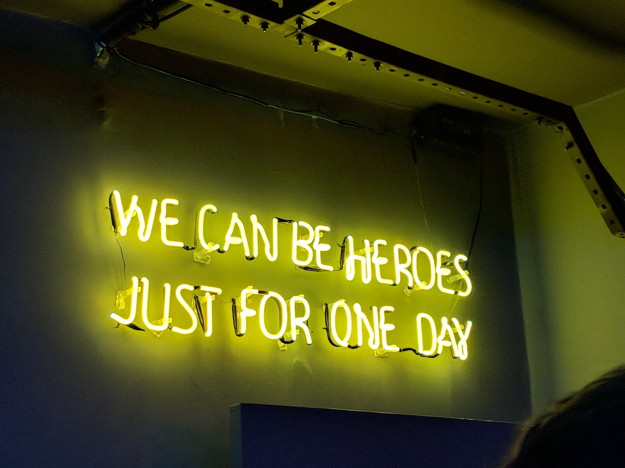When you think of producing content, the creative activity gets the most attention. It makes sense; every type of content relies on some form of artistic talent to create a good product.
But any successful content marketer knows it’s the destructive part of the creative process that’s delivering the best results.
Why?
Because content marketing is not about the art – it’s about the business.
What your audience wants from you is often different from what your executive team or board of directors thinks is best. The C-Suite wants you to toe the company line and push the brand. Historically, executive management has had good results from mass advertising so they want to keep broadcasting without considering the internet has ushered in a new kind of consumer who actively works to avoid advertising messages.
How can marketers ensure they’re making a positive impact on the business despite internal pressure to revert to old practices? How can you cultivate a loyal group of subscribers who trust in and depend on your content?
The best thing you can do is employ editors and give them the authority to defend your audience.

The unsung heroes of any creative pursuit are the editors
Editors work in all areas of content. While the tasks vary from discipline to discipline, every editor has one goal: to serve the audience. It’s the editor’s job to ensure every piece of content published by your brand is going to appeal to the people you’re trying to attract. They want the best possible outcome for your investment and they know it only happens when your customers are impressed with your content.
[tweet] Who are the unsung heroes of any creative pursuit? Can you guess? @SarahMitchellOz lays it out in this meaty post. #contentmarketing #creativelife #cmworld [/tweet]
Managing editor
The managing editor protects your audience from being bombarded with brand messages, sales pitches and marketing gobbledegook. A managing editor has oversight on all content – written, visual and audio. A good managing editor is guided by an editorial mission statement similar to those used in traditional media. You can also call it a content marketing mission statement and it should be defined in your content marketing strategy.
The managing editor reports to the business and is responsible for implementing your strategy. They determine what style guides to use, develop contributor and advertiser guidelines for your publications, and assist with the media kit.
Sidebar: What is an editorial mission statement?
An editorial mission statement will describe your audience, what content they’ll receive from you and what the outcome will be as a result of consuming your content. Think of it this way:
- Who are you going to help? Who is your target audience?
- How are you going to help them? What are you going to produce for your audience?
- What is changing in their life as a result? What is the outcome they’ll experience from your content?
With those three elements defined, an editor can ensure every piece of content you invest in will be of utmost value to your audience.
[tweet] Do you know how to craft an editorial mission statement? @SarahMitchellOz gives 3 critical elements you need to know. #cmworld #contentmarketing #editing [/tweet]
Text editor
A text editor reports to the managing editor. They work closely with writers to ensure the brief is met, the writing hits the right tone and each piece is fully developed with no inconsistencies. A text editor works with individual writers to get the best effort from them. They’ll trim fat in prose, make suggestions for improvements, develop story ideas, and help writers find the right angle for each story. They’re often responsible for writing titles and headlines.
If you don’t have strong writers on your team, a text editor can fill the quality gap of your final product.
RELATED: 7 editorial workflow tips from traditional publishing
Copyeditor
Once a text editor is happy with a piece of content and decides the writing is complete, a copyeditor takes over. (A copyeditor is sometimes called a subeditor.) A copyeditor is your quality control – the person who makes sure your grammar, punctuation and word usage are perfect. They enforce your style guide so everything you publish has the same consistency and quality. It’s an essential role often overlooked in brand publishing, but a copyeditor provides a seal of quality that will set your content apart. Don’t skip this step in your content production workflow.
If you want to learn more about what copyeditors do best, check out some of our best posts on copyediting.
- How a copyeditor can save your marketing bacon
- Commonly confused words and the rules to follow
- Copywriting 101: the royal order of adjectives
Sidebar: What is a style guide?
A style guide is a reference for publishing in your organisation. It sets standards for how things like quotations, abbreviations, job titles, dates and times, and citations will be written. Notable style guides include the Associated Press (AP) Stylebook (check out this AP Style cheat sheet), The Oxford Style Manual and The Chicago Manual of Style. A copyeditor may develop a style guide specific to your business if one isn’t selected by the managing editor
[tweet] Do you know the difference between a text editor and a copyeditor? A photo editor and a film editor? @SarahMitchellOz breaks it down. #cmworld #editor #editing [/tweet]

Photo editor
An increasingly important role is the photo editor. Verity Chambers teaches journalism and communications at Sydney TAFE Media and says a photo editor is vital to any publishing initiative.
“People respond to images, and often the people who are really strong wordsmiths are not terribly visually literate. I’ve had some amazing newspaper editors – like really great ones – who couldn’t judge a good picture to save themselves,” she says.
A former photo editor at the Sydney Morning Herald, Verity believes it’s an indispensable role for building trust with your audience.
“In this era of ‘fake news’, when so much information is so difficult to verify, a photographic specialist is an indispensable part of the verification process.”
Verity says a good photo editor can judge a great photograph, is a good manager and mentor, and knows their way around metadata and photo verification.
“And a good photo editor will fight to the death to ensure the best photograph(s) are published,” she says.
[tweet] A photographic specialist is an indispensable part of combating fake news according to @veritychambers. Find out why. #contentmarketing #editing #photography [/tweet]

Film editor
As video continues to grow in importance, content marketers must consider the role of the film editor. It’s easy to produce kilometres of film, but captivating a viewer from the beginning to the end of a video is difficult.
Rhys Waywood, Creative and Motion Designer at Lush, says a film editor takes “a lot of content and reduces it down to its essence.”
“It’s not uncommon to take 60 minutes of film and end up with a minute and a half when you’re done with the edit.”
If you’re creating video for social media, the margin for error can be seconds before you lose the attention of your audience.
“Social videos have to be really tight,” says Rhys. Plan on editing your videos down to 15 to 30 seconds or your audience will lose interest.
A film editor focuses on the narrative of a video. They’re responsible for making sure your talent looks smart, even if being on camera doesn’t come naturally. The people in your videos are likely to be your employees or customers – not paid actors – so the film editor has to fill in the gaps.
FURTHER READING: Why you need a content marketing editorial calendar
Look no further than YouTube to find a lot of bad editing. Rhys says some of the most common errors are:
- Jump cuts, where the camera ‘jumps’ from one scene to the next without a smooth transition
- Sentences cut in half or not finished
- Taking too long to get to the point
- Lingering on a scene longer than necessary
- Lack of continuity on the set or with the talent, when multiple shots are edited together.
Rhys say the fastest way to become a better editor is to practice. His favourite tools are from the Adobe Suite of products and include:
- Adobe Premiere Pro CC – Video editing software
- Adobe After Effects CC – Video effects software
- Adobe Audition CC – Audio editing software
A final word about editors
The editing process can create tension in your team. Most editors are masters at dealing with creative temperaments, but they also need the backing of management to get their job done. A mature creative team appreciates the guidance an editor provides and recognizes the undeniable value they add. When there’s an environment of trust between your creatives and your editors, your content moves to a new level of excellence.
So, next time an editor sends a project back asking for more information, requesting corrections or even telling you to start over, consider it a gift. When your editor fights to keep advertising and branding out of your content, listen to them. Your audience will thank you for taking their advice. But even better, your business will enjoy better results from content marketing.
If you’d like to improve the quality of your content – the effectiveness of your content marketing initiative – get in touch. Editing is a topic that never tires me out.
Note: An earlier version of this post appeared in the Slovenian print magazine, Kontekst.
